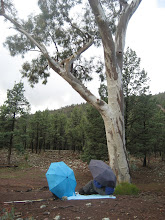Christchurch was not far behind when the mountain divide that separates Canterbury and West Coast came into view. The scene before us was the same that we had seen from the airplane. However, from the ground it became apparent that the magnificent landscape that dominated the area was not necessarily lifeless, and that the multi-coloredness came from contrasting vegetation and rocks.
The road follows the broad alluvial plain with its braided rivers--a series of small channels separated by small islands--a formation that is found only in a few places in the world.
As we drew closer to the Southern Alps we were in awe of the vast terrain that had been created by a rapid uplift and then eroded over time. Over millions of years the grey sandstone was carved by glaciers that left large scree slopes, steep gorges, and truncated ridges.
Vegetation at the lower elevations of the valley is limited to shrubs and grasses. In the riverbeds small patches of herbs, mosses and lichens can be seen. Forest of mountain beech, the only native tree to grow in the area, dot the hill sides.
Our first stop on the Great Alpine Highway was Kura Tawhiti/Castle Hill Conservation Area. The area's draw is a series of large, up to 30 meter high, limestone formations. The boulders can easily be observed from the Highway, but to really appreciate them it is well worth taking the 15 minute walk. The trail to the boulders is a well developed track, but once at the rock clusters visitors can meander through a network of worn but unmarked tracks. The day was perfect, but unfortunately time was against us. We wanted to make sure we found a camp site at Arthur's Pass before sunset, so we had to continue on our way.
my top openings in 2025 – bitesize sevilla
16 hours ago









Maya, your descriptions make your photos come so vivid. Thanks for sharing photos of a beautiful place.
ReplyDeleteCandi, New Zealand is not a place that lacks in natural beauty.
ReplyDelete